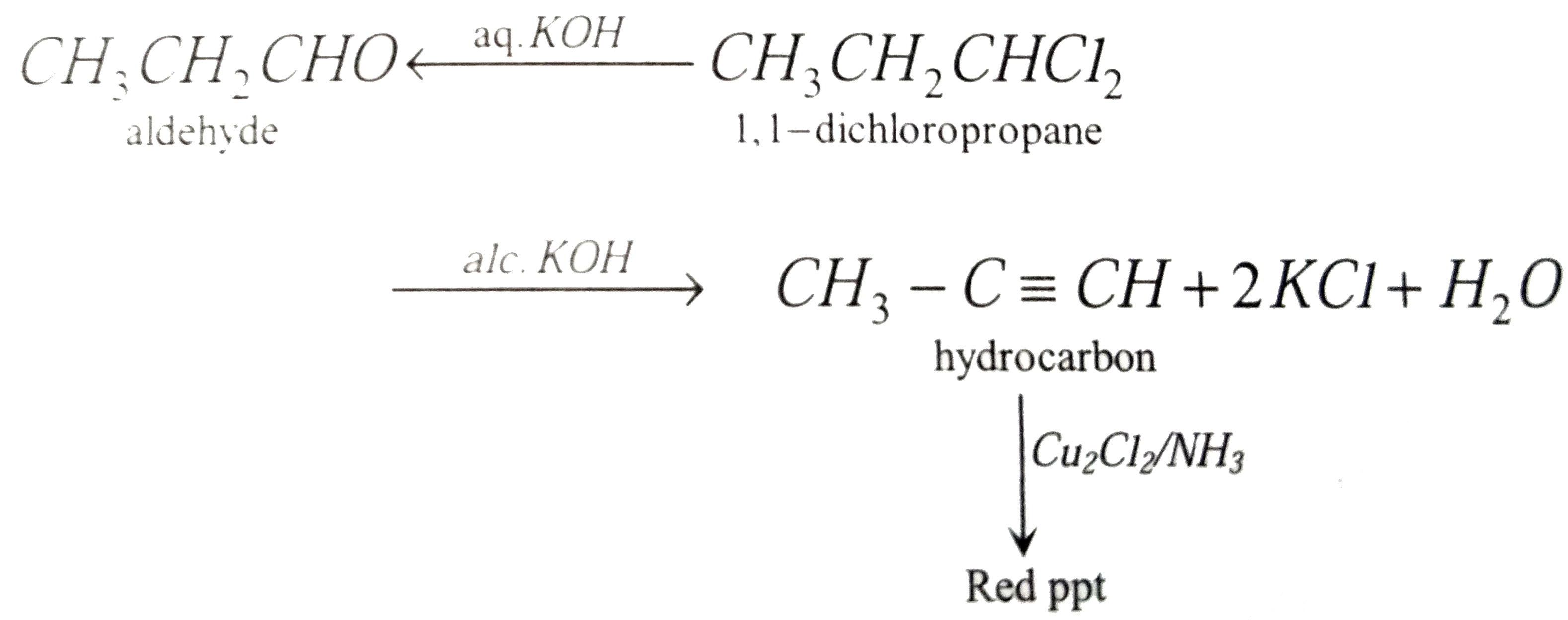A dihalogen dervative 'X' of a hydrocarbon with three carbon atoms reacts with alcoholic KOH and produces another hydrocarbon which forms a red precipitate with ammoniacal Cu2Cl2.'X' gives an aldehyde on reaction with aqueous KOH. The compound 'X' is :
1,3-dichloropropane
1,2-dichloropropane
2,2-dichloropropane
1,1-dichloropropane
The correct Answer is:D
The reaction sequence is as follows

Topper's Solved these Questions
- BOOK - ERRORLESS CHAPTER - HALOGEN CONTAINING COMPOUNDEXERCISE - Critical Thinking (Reasoning type Questions)2videos
HALOGEN CONTAINING COMPOUND
- BOOK - ERRORLESS CHAPTER - HALOGEN CONTAINING COMPOUNDEXERCISE - Critical Thinking (Comprehension type Questions)6videos
HALOGEN CONTAINING COMPOUND
- BOOK - ERRORLESS CHAPTER - HALOGEN CONTAINING COMPOUNDEXERCISE - Ordinary Thinking Objective Question (Uses of Halogen containing compounds)22videos
HALOGEN CONTAINING COMPOUND
- BOOK - ERRORLESS CHAPTER - GENERAL ORGANIC CHEMISTRYEXERCISE - Matrix Match type questions4videos
GENERAL ORGANIC CHEMISTRY
- BOOK - ERRORLESS CHAPTER - HYDROCARBONEXERCISE - JEE SECTION (Matrix Match type questions)6videos
HYDROCARBON
Similar Questions
A dihalogen derivative (A) of a hydrocarbon having two carbon atoms reacts with alcoholic potash and forms another hydrocarbon which gives a red precipitate with ammoniacal cuprous chloride. Compound A gives an aldehyde when treated with aqueous KOH. Write down the name and formula for the organic compound.
View SolutionA hydrocarbon (A) on chlorinatio gives (B) ,which on reacting with alcoholic KOH changes into another hydrocarbon (C ) .The latter decolorizes Bayer's reagent and on ozonolysis forms formaldehyde only (A) is:
View Solution
Knowledge Check
- Question 1 - Select One
A dihalogen derivative 'X' of hydrocarbon with three carbon atom reacts with alcoholic KOH and produces another hydrocarbon which forms a red precipitate with ammoniacal Cu2Cl2. 'X' gives an aldehyde on reaction with aqueous KOH. The compound X is
A1, 3-Dichloro propaneB1, 2-DichloropropaneC2, 2-DichloropropaneD1, 1-Dichloropropane - Question 2 - Select One
A gas which reacts with aqueous KMnO4 solution but does not give precipitates with ammonical Cu2Cl2 solution is
AEthyleneBMethaneCEthaneDAcetylene - Question 3 - Select One
2-Chloro-2-methylpropane on reaction with aqueous KOH gives X as the major product. X is
A2-ButeneB2-MethylpropeneC1-ButeneD2-Methyl-2-propanol
The unsaturated hydrocarbon obtained by the reaction of a dihalogen derivative with alcoholic potash gives a red precipitate with ammoniacal cuprous chloride. The dihalogen derivative gives propanal on heating with aqueous potash. The dihalogen derivative is:
View SolutionThe unsaturated hydrocarbon obtained by the reaction of a dihalogen derivative with alcoholic potash gives a red precipitate with ammoniacal cuprous chloride. The dihalogen derivative gives propanal on heating with aqueous potash. The dihalogen derivative is:
View SolutionThe unsaturated hydrocarbon obtained by the reaction of a dihalogen derivative with alcoholic potash gives a red precipitate with ammonical cuprous chloride. The dihalogen derivative gives propanal on heating with aqueous potash. The dihalogen derivative is
View SolutionA dihalogen derivative (A) with three C-atoms gives a hydrocarbon (B) on reacting with alc KOH. (B) gives a white precipitate with Tollen’s reagent. (A) on heating with aqueous KOH gives a ketone. Compound (A) is:
View SolutionA dihalogen derivative (A) with three C-atoms gives a hydrocarbon (B) on reacting with alco. KOH. (B) gives a white precipitate with Tollen's reagent. (A) on heating with aqueous KOH gives a ketone. Compound (A) is
View Solution

